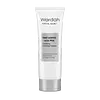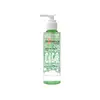What's inside
What's inside
 Key Ingredients
Key Ingredients

 Benefits
Benefits

 Concerns
Concerns

 Ingredients Side-by-side
Ingredients Side-by-side

Water
Skin ConditioningGlycerin
HumectantAcrylates Copolymer
Cocamidopropyl Betaine
CleansingPropylene Glycol
HumectantSodium Laureth Sulfate
CleansingPotassium Cocoyl Glycinate
Decyl Glucoside
CleansingSodium Lauroyl Methyl Isethionate
CleansingSodium PCA
HumectantPotassium Cocoate
EmulsifyingSodium Chloride
MaskingPhenoxyethanol
PreservativeSodium Hydroxide
BufferingParfum
MaskingDMDM Hydantoin
PreservativeGluconolactone
Skin ConditioningZea Mays Starch
AbsorbentMannitol
HumectantMicrocrystalline Cellulose
AbsorbentEthylhexylglycerin
Skin ConditioningDisodium EDTA
Trisodium Ethylenediamine Disuccinate
Sodium Benzoate
MaskingLactic Acid
BufferingGlycolic Acid
BufferingMica
Cosmetic ColorantCitric Acid
BufferingCitrus Aurantium Dulcis Fruit Extract
MaskingHydroxypropyl Starch Phosphate
Tocopheryl Acetate
AntioxidantLeontopodium Alpinum Extract
Skin ConditioningMalic Acid
BufferingSaccharum Officinarum Extract
MoisturisingTartaric Acid
BufferingPotassium Sorbate
PreservativeAcer Saccharum Extract
Skin ConditioningCitrus Limon Fruit Extract
MaskingVaccinium Myrtillus Fruit Extract
Skin ConditioningCI 77891
Cosmetic ColorantCI 77499
Cosmetic ColorantWater, Glycerin, Acrylates Copolymer, Cocamidopropyl Betaine, Propylene Glycol, Sodium Laureth Sulfate, Potassium Cocoyl Glycinate, Decyl Glucoside, Sodium Lauroyl Methyl Isethionate, Sodium PCA, Potassium Cocoate, Sodium Chloride, Phenoxyethanol, Sodium Hydroxide, Parfum, DMDM Hydantoin, Gluconolactone, Zea Mays Starch, Mannitol, Microcrystalline Cellulose, Ethylhexylglycerin, Disodium EDTA, Trisodium Ethylenediamine Disuccinate, Sodium Benzoate, Lactic Acid, Glycolic Acid, Mica, Citric Acid, Citrus Aurantium Dulcis Fruit Extract, Hydroxypropyl Starch Phosphate, Tocopheryl Acetate, Leontopodium Alpinum Extract, Malic Acid, Saccharum Officinarum Extract, Tartaric Acid, Potassium Sorbate, Acer Saccharum Extract, Citrus Limon Fruit Extract, Vaccinium Myrtillus Fruit Extract, CI 77891, CI 77499
Water
Skin ConditioningGlycerin
HumectantCocamidopropyl Betaine
CleansingAmmonium Lauryl Sulfate
CleansingSodium Cocoyl Alaninate
Acrylates Copolymer
PEG-8 Caprylic/Capric Glycerides
EmulsifyingMannitol
HumectantSodium Hydroxide
BufferingSodium Metabisulfite
AntioxidantMicrocrystalline Cellulose
AbsorbentSucrose
HumectantZea Mays Starch
AbsorbentNiacinamide
SmoothingEuglena Gracilis Extract
Skin ConditioningHydroxypropyl Methylcellulose
Emulsion StabilisingButylene Glycol
HumectantCentella Asiatica Extract
CleansingCentella Asiatica Leaf Extract
Skin ConditioningTocopherol
AntioxidantDisodium EDTA
Phenoxyethanol
PreservativeChlorphenesin
AntimicrobialCI 74260
Cosmetic ColorantCI 11710
Cosmetic ColorantWater, Glycerin, Cocamidopropyl Betaine, Ammonium Lauryl Sulfate, Sodium Cocoyl Alaninate, Acrylates Copolymer, PEG-8 Caprylic/Capric Glycerides, Mannitol, Sodium Hydroxide, Sodium Metabisulfite, Microcrystalline Cellulose, Sucrose, Zea Mays Starch, Niacinamide, Euglena Gracilis Extract, Hydroxypropyl Methylcellulose, Butylene Glycol, Centella Asiatica Extract, Centella Asiatica Leaf Extract, Tocopherol, Disodium EDTA, Phenoxyethanol, Chlorphenesin, CI 74260, CI 11710
 Reviews
Reviews

Ingredients Explained
These ingredients are found in both products.
Ingredients higher up in an ingredient list are typically present in a larger amount.
Acrylates Copolymer is used as a film-forming agent and texture enhancer.
After applied, Acrylates Copolymer forms a thin film cover that helps skin feel more soft. It can help sunscreens become more water-resistant.
It is also used to make a product more thick.
Learn more about Acrylates CopolymerCocamidopropyl Betaine is a fatty acid created by mixing similar compounds in coconut oil and dimethylaminopropylamine, a compound with two amino groups.
This ingredient is a surfactant and cleanser. It helps gather the dirt, pollutants, and other impurities in your skin to be washed away. It also helps thicken a product and make the texture more creamy.
Being created from coconut oil means Cocamidopropyl Betaine is hydrating for the skin.
While Cocamidopropyl Betaine was believed to be an allergen, a study from 2012 disproved this. It found two compounds in unpure Cocamidopropyl Betaine to be the irritants: aminoamide and 3-dimethylaminopropylamine. High-grade and pure Cocamidopropyl Betaine did not induce allergic reactions during this study.
Learn more about Cocamidopropyl BetaineDisodium EDTA plays a role in making products more stable by aiding other preservatives.
It is a chelating agent, meaning it neutralizes metal ions that may be found in a product.
Disodium EDTA is a salt of edetic acid and is found to be safe in cosmetic ingredients.
Learn more about Disodium EDTAGlycerin is already naturally found in your skin. It helps moisturize and protect your skin.
A study from 2016 found glycerin to be more effective as a humectant than AHAs and hyaluronic acid.
As a humectant, it helps the skin stay hydrated by pulling moisture to your skin. The low molecular weight of glycerin allows it to pull moisture into the deeper layers of your skin.
Hydrated skin improves your skin barrier; Your skin barrier helps protect against irritants and bacteria.
Glycerin has also been found to have antimicrobial and antiviral properties. Due to these properties, glycerin is often used in wound and burn treatments.
In cosmetics, glycerin is usually derived from plants such as soybean or palm. However, it can also be sourced from animals, such as tallow or animal fat.
This ingredient is organic, colorless, odorless, and non-toxic.
Glycerin is the name for this ingredient in American English. British English uses Glycerol/Glycerine.
Learn more about GlycerinMannitol is a sugar alcohol. It is a humectant and moisturizes the skin. In vitro (not tested on a living organism), mannitol displays antioxidant properties.
When found in aqueous solutions, mannitol tends to become acidic. This is because it loses a hydrogen ion. This is why mannitol can often be found with pH adjusting ingredients, such as sodium bicarbonate.
Fun fact: Mannitol can be found in foods as a sweetener. It can be naturally found in mushrooms, algae, fruits, and veggies.
Learn more about MannitolMicrocrystalline Cellulose is another name for refined wood pulp. It is used as an emulsifier and mattifying ingredient. As an emulsifier, it helps keep ingredients together.
Phenoxyethanol is a preservative that has germicide, antimicrobial, and aromatic properties. Studies show that phenoxyethanol can prevent microbial growth. By itself, it has a scent that is similar to that of a rose.
It's often used in formulations along with Caprylyl Glycol to preserve the shelf life of products.
Sodium Hydroxide is also known as lye or caustic soda. It is used to adjust the pH of products; many ingredients require a specific pH to be effective.
In small amounts, sodium hydroxide is considered safe to use. However, large amounts may cause chemical burns due to its high alkaline.
Your skin has a natural pH and acid mantle. This acid mantle helps prevent harmful bacteria from breaking through. The acid mantle also helps keep your skin hydrated.
"Alkaline" refers to a high pH level. A low pH level would be considered acidic.
Learn more about Sodium HydroxideWater. It's the most common cosmetic ingredient of all. You'll usually see it at the top of ingredient lists, meaning that it makes up the largest part of the product.
So why is it so popular? Water most often acts as a solvent - this means that it helps dissolve other ingredients into the formulation.
You'll also recognize water as that liquid we all need to stay alive. If you see this, drink a glass of water. Stay hydrated!
Learn more about WaterZea Mays Starch is starch made from corn. You might know this as cornstarch . It is used to thicken a product. It can replace talc as an absorbent.
The pH of cornstarch is 5.92.
Cornstarch is a common food ingredient used to thicken soups or to make corn syrup.
Learn more about Zea Mays Starch